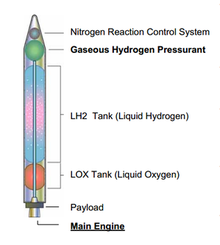Aquarius (rocket)
 | |
| Function | SSTO Expendable launch system |
|---|---|
| Manufacturer | Space Systems/Loral, Aerojet, Microcosm |
| Country of origin | United States |
| Size | |
| Height | 43.00 m (141.08 ft) |
| Diameter | 4 m (13 ft) |
| Mass | 130,000 kg (290,000 lb) (10,000 kg (22,000 lb) empty) |
| Stages | 1 |
| Capacity | |
| Payload to LEO | |
| Mass | 1,000 kg (2,200 lb) to a 200 km orbit |
| Launch history | |
| Status | Cancelled |
| Launch sites | Hawaii |
| Total launches | 0 |
| stage | |
| Powered by | 1 |
| Maximum thrust | 400,000 lbf (1.8 MN) |
| Propellant | LOX/LH2 |
Aquarius is a launch vehicle concept designed for low-cost by Space Systems/Loral to carry small, inexpensive payloads into LEO.
Concept[edit]
The vehicle was primarily intended for launching bulk products, like water, fuel, and other consumables, that are inexpensive to replace in the event of a launch failure. The target launch cost was $1 million. Aquarius was designed to be a single-stage vehicle 43 meters (141 ft) high and 4 meters (13.1 ft) in diameter and powered by a single pressure fed engine using liquid hydrogen and oxygen propellants stored in a composite pressure tank.[1] Launch would have taken place from a floating position in the ocean to minimize launch infrastructure with the ability to place a 1,000-kilogram (2,200 lb) payload into a 200-kilometer (120 mi), 52-degree orbit. The payload, located in the base of the vehicle, would be extracted by an orbiting space tug for transfer to its ultimate destination, like the ISS or a propellant depot, after which the vehicle would de-orbit and be destroyed.[2]
Vortex Cooled Chamber Wall Engine[edit]
Space Systems/Loral teamed with Microcosm, and Wilson Composite Technologies to study Aquarius under a $110,000 grant awarded by the state of California in April 2001 and delivered a final report in June 2002.
Funding of $1 million was provided in the FY 2004 Defense Appropriations Act to develop a prototype of the low-cost engine for the vehicle. The engine would provide 400,000 pounds-force (1.8 MN) of thrust using liquid oxygen and liquid hydrogen as propellants. For the engine development, Space Systems/Loral is partnered with Aerojet, ORBITEC and Microcosm, under the auspices of the Air Force Research Laboratory and was completed in 2006.[3][4] It confirmed that an ORBITEC engine design with inherently low cost can be scaled up to an intermediate thrust level, from which the next scale-up step to Aquarius should be achievable. [5][6]
COTS bid[edit]
The proposal made with Constellation Services International for Commercial Orbital Transportation Services in 2006 was not selected.[7]$150 million was the planned development cost, as part of a $700 million project (that included a space tug). 100 launches per year were needed to be profitable. One third of the launches were by design allowed to fail. Target costs were $1 million per launch or $1000/kg to LEO.[1]
Design specification[edit]
- Diameter: 4 meters (12.6 feet)[4]
- LH2 tank length: 21 meters (69 feet)
- LOX tank length: 8.4 meters (28 feet)
- GH2 Pressurant tank length: 4 meters
- Total height : 43 metres (140 feet)[4]
See also[edit]
References[edit]
- ^ a b "aquarius". astronautix.com. Archived from the original on November 12, 2011. Retrieved February 13, 2012.
- ^ Andrew E. Turner (January 30, 2006). "Low-cost launch and orbital depots: the Aquarius system". thespacereview.com.
- ^ Andrew E. Turner; Aaron Leichner (2006-10-24). "Hydrogen Pressurization of LOX: High Risk/High Reward" (PDF). dtic.mil. Archived (PDF) from the original on March 3, 2016.
- ^ a b c Andrew E. Turner (2005). "AQUARIUS LOW COST LAUNCH MAIN ENGINE STUDY" (PDF). AIAA. responsivespace.com. p. 24. Archived from the original (PDF) on 2006-05-16.
- ^ "2006 U.S. COMMERCIAL SPACE TRANSPORTATION DEVELOPMENTS AND CONCEPTS: VEHICLES, TECHNOLOGIES, AND SPACEPORTS" (PDF). Commercial Space Transportation Office. p. 20.
- ^ Andrew W. Turner; William H. Knuth (March–April 2006). "The Vortex Cooled Chamber Wall Engine: A Tamed Tornado" (PDF). SPACE TIMES Magazine. Archived from the original on April 8, 2013.
- ^ "Space Systems/Loral Proposes Bus for NASA's Cargo Needs" (Press release). Space News. 2007-12-10. Archived from the original on 12 December 2007. Retrieved 2007-12-10.
- Space Time magazine, May/June 2001
External links[edit]
- Video presentation Aquarius concept Part 1
- Video presentation Aquarius concept Part 2
- Audio interview Andrew E. Turner on the space show
- Ocean-based launch: extending a successful approach to new applications , Andrew E. Turner , the space review 2007
- JOHN R. LONDON III (October 1994). LEO on the Cheap. Air University Press. ISBN 0-89499-134-5.
